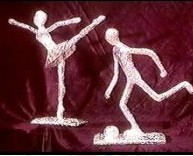|
|
Anna Esteban, Llicència d'estudis a St Helens, 2005-06 |
2. Working with wire, modroc and
foil

| Sessions |
Two or three
|
|
| Focus |
To make figures using
wire, modroc and foil.
To learn skills to arrange materials. To learn about the work of local sculptors, known artists and different sculptures. |
|
| Material |
Flexi wire
Modroc Cardboard, box card. Tape, sticky tape Aluminium foil Water container Acrylic or poster paint |
|
| Resources |
Pictures from different kind of sculptures. |
Books: Art 3 and Art 4, Step by Step Webs: The Standards Site: Art Attack |
| Talk about |
Famous artist in the village, what are the their sculptures made of? Explore about the material they used. Using Stone or Wood like Henry Moore, Wire and mobiles as Alexander Calder or found materials as Picasso. Show some of their works. The purpose of the sculptures, are they long lasting, temporary, to resist weather? How to use wire, Modroc and foil. Which kind of materials are they? How can they be arrange together. How to use them in a safe way, i.e.( making a loom at the end of wire.) Show them how these methods are: bending, twisting, looping and curving.
Modroc dries very quickly and gets hard. |
|
|
Sketchbook |
To record best from observations or pictures of sculptures of the area, the name of the artist and the title of each piece. Sketch some of the shapes or figures they see. They will use one of them. Write down how to use wire safety and how to use Modroc. Look at the word "Armature" and write down what it means. |
|
|
|
Activity 1: Wire and Modroc figures 1 - Choose some strips of wire and bend a loop at each
end before begin joining the structure together. Start to make the
thickness' part first. This may need several pieces twisted and curled
together as it will need to be strong and firm before you begin adding
parts. Activity 2: Aluminium figures 1 - Start by scrunching up newspaper into a body shape.
Use plenty of sticky tape to hold it in shape and Twist some strips of
newspaper into arms and legs and arrange them with tape. Bend the bottom
of the legs to make the feet. |
|
|
|
|
|
| Vocabulary and language |
Wrap
Modroc Wire Trunk Scrunching Twist Bend Strips |
Natural materials: grass, bark, pebbles, leaves. Made materials: fabric, card, clay tiles, plastic Visual qualities: Shape, form colour. Tactile qualities: hard, soft, rough, smooth, rigid Materials and processes: sculpture, carving, modelling, constructing. |
|
Assessment |
- Investigate and use materials and processes to communicate ideas and meaning in 3D form. - Describe what they think or feel about their own work and other' work. - Encourage to identify qualities in their work. Use the vocabulary to help description in English. |
|